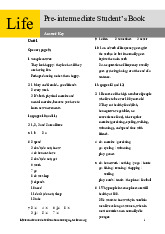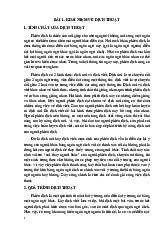




Preview text:
LESSON PLAN
TIẾNG ANH 11 FRIENDS GLOBAL
UNIT 3: SUSTAINABLE HEALTH
LESSON 3D – GRAMMAR: FUTURE CONTINUOUS AND FUTURE PERFECT I. OBJECTIVES
By the end of this lesson, Ss will be able to: 1. Knowledge
- Use future continuous and future perfect.
- Know some predictions of how humans will change over the next 100.000 years.
- Gain some expressions about future time. 2. Competences
- Understand an article about how humans are predicted to change over the next 100,000 years.
- Discussing predictions about the future.
- Develop self-study skills, collaborative skills and creativity. 3. Personal qualities
- Be more aware of changes in the far future.
- Be collaborative and supportive in pair work and teamwork.
- Actively join in class activities. II. MATERIALS
- Grade 11 textbook, Unit 3, Grammar
- Computer connected to the Internet - Projector / TV/ mini boards - PowerPoint Unit 3D III. PROCEDURES
1. ACTIVITY 1: GRAMMA REVIEW / WARM-UP (10 mins) a. Objectives:
- Get students' attention at the beginning of the class.
- Students can gain more confidence and interest in the lesson.
- Ss can review the grammar of the previous lesson. b. Content:
- Sentence building (Game) - Exercise 1. (p.40) c. Products:
- Students write their answers on the mini boards, discuss with their friends. d. Organisation
TEACHER’S AND STUDENTS’ ACTIVITIES CONTENT Sentence building (5 mins)
- Teacher goes through the slide to review the grammar 1. it / rain / tomorrow (70%) of the previous lesson.
2. An / pass all his exams (100%) - T elicits the language.
3. John / play computer games this evening - Ss work in teams. (10%)
- Ss will see a prompt, and write a sentence based on the 4. I / go to bed late tonight (0%) prompt on their mini boards.
5. If scientists / find cure for most diseases,
- The first team to finish with the correct sentence will
people / live much longer. (90%)
get to choose a box that contains either plus point (+) or 6. I’m sure bio-printing of organs / become minus point (-) a reality.
Exercise 1: What differences can you see between the first and last pair of photos? (2 mins)
- T focuses attention on the photos. In pairs, students (Possible answer)
describe the differences between the first and last set of
In the last photo, the people have bigger photos.
eyes, larger noses and nostrils, larger brains
- T asks a few students to share their ideas with the
and foreheads and darker skin. class.
Exercise 2: Read the article. Did you mention any differences in exercise 1 that are not mentioned in the text? (3 mins)
- Students read the article and compare their answers Reading text (p. 40) from exercise 1.
- T elicits any differences that are not mentioned in the text e. Assessment
- Teacher observes the groups and discussion.
- T gives feedback to group answers and individual answers.
2. ACTIVITY 2: PRESENTATION (10 mins) a. Objectives:
- Ss know the forms and when to use future continuous and future perfect. b. Content: - Exercise 3 (p.38) c. Products:
- Students complete Learn this! box in the book. d. Organisation
TEACHER’S AND STUDENTS’ ACTIVITIES CONTENT
Exercise 3: Read the Learn this! box. Complete the examples and rules. How many more
examples of each tense can you find in the article? (10 mins)
- T asks students to read the Learn this! box and Answers: complete the rules.
1 will have 2 will be 3 perfect 4 continuous
- Students find examples of the tenses in the article in exercise 2.
future perfect 5: how will the human body - T checks answers as a class
have changed in 100,000 years? as a result,
our eyelids will have become thicker …; our
nostrils will have grown larger …; the size
of our skull will have increased …; our brain will have got larger.
future continuous 2: humans will be living in
other pats of the solar system.; … we will be
using a nano-chip inside our head … e. Assessment
- Teacher checks students’ books.
3. ACTIVITY 3: PRACTICE (15 mins) a. Objectives:
- Ss get used to the form and use of future continuous and future perfect.
- Ss use the future tenses in some exercises correctly. b. Content:
- Grammar builder 3.3 (p.119) - Exercise 4. (p.40) c. Products:
- Students complete exercises in their books. d. Organisation
TEACHER’S AND STUDENTS’ ACTIVITIES CONTENT
Grammar builder 3.3: (10 mins)
Exercise 1: Complete the sentences with the future continuous form of the verbs below
Exercise 2: Complete the sentences. Use the future perfect form of the verbs in brackets
- Ss work in pairs to complete the exercise in 5 Answer key: minutes. Exercise 1:
- T invites some Ss to go up to the board to write 1 will be studying 2 will be having their answers.
3 will be shining 4 will be visiting
- Other Ss check the answers on the board and give 5 will be packing 6 will be staying feedback. Exercise 2: - T corrects the exercise.
1 will have returned 2 won’t have finished
3 won’t have received 4 will have done
5 won’t have had 6 will have been
Exercise 4: Complete the sentences using the correct future continuous or future perfect form of
the verbs in brackets. (5 mins)
- Working individually, students complete the Answer key: sentences.
1 will have finished 2 will be working 3 won’t be
- T checks answers as a class.
living 4 will have told 5 will be shining e. Assessment
- Teacher observation on Ss’ performance.
- Teacher’s feedback and peers’ feedback.
4. ACTIVITY 4: PRODUCTION (10 mins) a. Objectives:
- Ss can use future time expressions in their talk.
- Ss can discuss predictions about the future. b. Content: - Exercise 5. (p.40) - Exercise 7. (p.40) c. Products:
- Students take notes in their books, discuss with their friends, then report. d. Organisation
TEACHER’S AND STUDENTS’ ACTIVITIES CONTENT
Exercise 5: Read the Learn this! box. Add two more time expressions from the article in exercise 2 (2 mins)
- T goes through the Learn this! box and check the Answer key:
meaning and pronunciation of within /wɪðˈɪn/ (in a in 100,000 years; in the distant future
period not longer than a particular length of time),
by /baɪ/ (not later than; before), foreseeable
/fɔːˈsiːəbl/ (that can be expected; that you can guess
will happen) and long term /lɒŋ tɜːm/ (for a long period of time).
- Students find two more time expressions in the article in exercise 2.
- T checks answers as a class.
Exercise 6: Read the prompts. Then in pairs, make predictions using the future continuous or
future perfect and a suitable time expression. Do you agree with your friend? (8 mins)
- T goes through the instructions and the prompts. (Possible answers)
- T asks students to make predictions with any of 2 I think / don’t think most people will be living to
the time expressions in the Learn this! box. 200 years from now.
- Students write their predictions in their 3 I think / don’t think new diseases will have notebooks.
appeared in 1,000 years’ time.
- T circulates and monitor, helping where 4 I think / don’t think computers will be managing necessary.
all major companies in the foreseeable future.
- In pairs, students take turns to read out their 5 I think / don’t think the earth will be fighting
predictions and give their opinions.
wars against other planets 10,000 years from now
- A few students volunteer to share their ideas with the class e. Assessment
- Teacher observation on Ss’ performance.
- Teacher’s feedback and peers’ feedback. 4. CONSOLIDATION (2 mins) a. Wrap-up
- If T is using the Classroom Presentation Tool, first do the lesson closer to review what has been covered in this lesson.
- T asks students: What have you learned today? What can you do now? and elicits answers: I
can talk about events in the future and when they will happen, using the future continuous and future perfect. b. Homework
- Prepare for the next lesson




